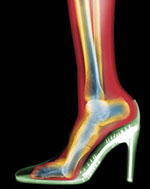When we contacted Nick Veasey regarding his X-ray photography he was keen that our comments should concentrate upon the artistic aspects of his images rather than the techniques he employs to create them. Wonderful - that's surely how it should be! Such an approach also suited us fine because the focus of the Society as a whole is very much on the art rather than the science of photography. Anyway, the technical quality of Nick’s images is nothing less than obvious.
In 1895 a German physicist, Wilhelm Rontgen, discovered that photographic emulsions were sensitive not only to the the wavelengths of the visible spectrum but also those that he named X-rays. X-rays have higher energy than radiation within the visible spectrum and their wavelengths lie beyond those of the ultraviolet region. Rontgen became particularly interested when he realized that his newly discovered rays penetrated and even traversed organic matter such as the human body. He soon found that the different densities of flesh, bone and cartilage could be rendered visible on a sensitized plate placed behind a subject. This allowed the internal structure and organs of the body to be photographed for the first time, and led to a revolution in medical diagnosis and treatment.
 |
| Image by kind permission of Nick Veasey |
The use of X-rays for purely artistic purposes is not entirely new. The earliest images, created largely out of curiosity, were produced soon after the basic technology was developed. However, the necessary equipment remains expensive and its safe use is dependent upon an appropriate environment and quite a bit of specialized knowledge and expertise.
Nick Veasey, a British artist based in Kent, has taken this art form further than most and has published several books on the subject. X-ray (Goodman - Carlton Books Ltd, ISBN 978-1-84796-000-9), which presents a stunning collection of his unique work, was published in 2008. As one turns the pages, often wondering how on Earth the images were created, each picture has a different impact. A few might conceivably still be regarded by some viewers as interesting diversions, and factual, ghostly or scientific in nature. However, most of the images are nothing less than extraordinary - a few might even be described as disturbing. What seems beyond doubt is that Nick’s images are very competent and beautiful works of art.
His “stiletto” image, seen at least initially through the penetrating eyes of an X-ray machine, is arguably without equal. It is commonly said that X-ray art turns objects inside out, but this image does much more. Not only are we able to see the inner elements of a female foot and a very high stiletto-heeled shoe, but also the outer surfaces and sensuous shapes of a slender lower leg and ankle. The skilful addition of colour to the basic X-ray image, which helps in large measure to achieve this end, has produced an image far removed from the hard and soulless reality of a medical x-ray. Yes, the bones and joints are there just as they are in a clinical image, but somehow they have acquired a three-dimensional reality which brings them back closer to everyday experience for an untrained eye. The bones of the lower leg, the tibia and smaller fibula, have a glowing porcelain-like quality with beautiful form and colour gradation. The colours themselves warm or cool each angle and element, and hence the overall image, to the point where the picture seems attractively human.
Textural quality also contributes significantly to the image. The bones of the leg and ankle are seen to have quite different surfaces. Those of the lower leg are smooth, slender and gently curved, reflecting the lines of an elegant female limb. Those of the ankle joint are more textured and rugged, and we see how the outer covering of flesh smoothes the foot in to the gentler form with which we are more familiar.
The stiletto-heeled shoe is something else altogether. The image reveals it to be exactly what it is - elegantly designed but potentially cruel and dangerous. Perhaps the most obvious elements of its normally-hidden inner self are those spitefully sharp tacks hovering just below the soft flesh of the foot where they lurk, we imagine, waiting for their opportunity to cause terrible pain and destruction. The slender steel spine of the heel is also revealed as potentially lethal - both to the delicate fabric of the gently-curving heel immediately above, and to the surface of the floor on which it stands. Finally, we see the excruciating angles imposed upon the metatarsals and toe joints, and are left wondering how the human form copes with such fashionable excesses.






